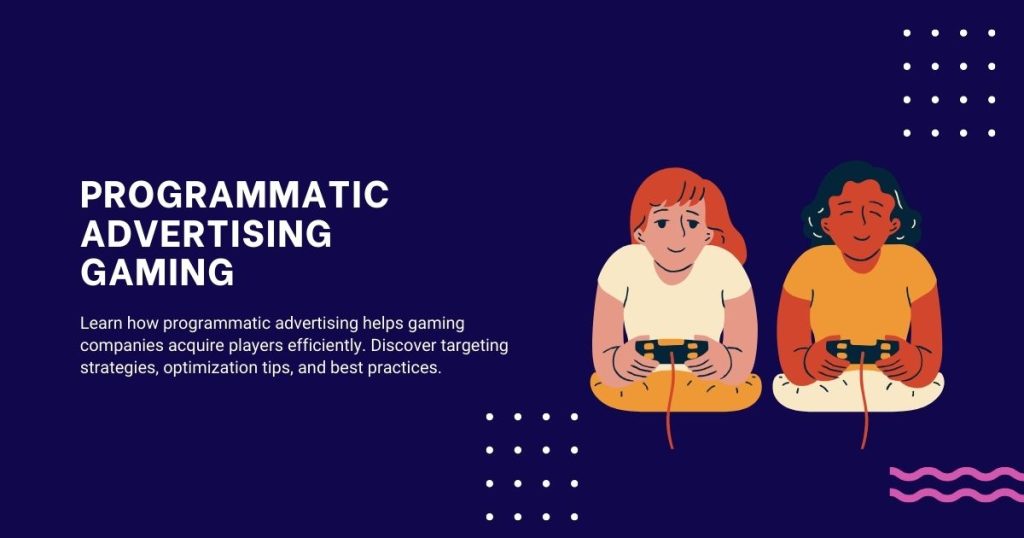How Programmatic Advertising is Revolutionizing Gaming Marketing

The gaming industry generates over $184 billion annually, making it larger than movies and music combined. With millions of players across mobile, console, and PC platforms, reaching the right audience has become increasingly complex. Traditional advertising methods often miss the mark, leading to wasted budgets and poor user acquisition results.
Programmatic advertising has emerged as a game-changer for marketing teams in the gaming space. By automating ad buying and leveraging real-time data, this technology helps gaming companies connect with their ideal players more efficiently than ever before. Instead of manually negotiating ad placements and hoping for the best, programmatic platforms use algorithms to bid on ad inventory in milliseconds, ensuring your ads reach the most relevant audiences at the optimal price.
This comprehensive guide explores how programmatic advertising works specifically for gaming companies, the unique benefits it offers, and practical strategies you can implement to improve your user acquisition campaigns.
Understanding Programmatic Advertising in Gaming

Programmatic advertising refers to the automated buying and selling of digital ad inventory using software platforms. Rather than traditional methods involving manual negotiations and insertion orders, programmatic systems use real-time bidding (RTB) to purchase ad placements automatically.
For gaming companies, this technology offers unprecedented precision in targeting potential players. The system analyzes vast amounts of data points, including demographics, interests, gaming preferences, device types, and behavioral patterns, to determine which users are most likely to download and engage with your game.
The process happens in real-time as users browse websites or use mobile apps. When an ad space becomes available, multiple advertisers can bid for that placement through programmatic platforms. The highest bidder wins the auction, and their ad is displayed to the user—all within the time it takes for a webpage to load.
Key Components of Programmatic Advertising
Demand-Side Platforms (DSPs) allow gaming advertisers to bid on ad inventory across multiple exchanges and networks from a single interface. Popular DSPs for gaming include The Trade Desk, Amazon DSP, and Google Display & Video 360.
Supply-Side Platforms (SSPs) help publishers and app developers sell their ad inventory to the highest bidders. Major SSPs include Google Ad Manager, Magnite, and PubMatic.
Ad Exchanges serve as digital marketplaces where DSPs and SSPs connect to facilitate real-time auctions for ad placements.
Data Management Platforms (DMPs) collect and organize audience data from various sources to help create more targeted advertising campaigns.
Why Gaming Companies Are Embracing Programmatic
The gaming industry faces unique marketing challenges that programmatic advertising addresses effectively. Mobile games, in particular, operate in a highly competitive environment where user acquisition costs continue to rise while organic discovery becomes more difficult.
Enhanced Targeting Capabilities
Programmatic platforms excel at identifying and reaching gaming audiences across multiple dimensions. You can target users based on their gaming behavior, such as players who frequently download puzzle games or those who make in-app purchases. Location-based targeting helps promote region-specific events or tournaments, while device targeting ensures your ads display properly across different screen sizes and operating systems.
Lookalike modeling allows you to find new users who share characteristics with your existing high-value players. This approach typically yields better results than broad demographic targeting because it focuses on behavioral similarities rather than surface-level attributes.
Real-Time Optimization
Traditional advertising campaigns require manual adjustments based on periodic performance reviews. Programmatic systems continuously optimize campaigns in real-time, automatically shifting budgets toward the best-performing audiences, placements, and creative variations.
This dynamic optimization is particularly valuable for gaming companies launching new titles or seasonal content. The system can quickly identify which player segments respond best to different messaging and allocate spend accordingly.
Cost Efficiency and Transparency
Programmatic advertising operates on auction-based pricing, which typically results in more competitive rates than fixed-price deals. You only pay what’s necessary to win each auction, and detailed reporting shows exactly where your budget goes.
This transparency helps gaming marketers understand which channels, audiences, and creative formats deliver the best return on ad spend (ROAS). You can see performance data down to individual placements and make data-driven decisions about future campaigns.
Programmatic Strategies for Different Gaming Segments
Mobile Gaming
Mobile games represent the largest segment of the gaming market, accounting for over half of all gaming revenue. Programmatic advertising excels in this space because mobile devices generate rich behavioral data that improves targeting accuracy.
In-app advertising works particularly well for mobile game promotion. You can reach users while they’re already engaged with gaming content, making them more likely to try new titles. Video ads showcasing gameplay footage tend to perform better than static banners, as they give potential players a clear preview of the gaming experience.
Retargeting campaigns help re-engage users who previously downloaded your game but haven’t played recently. You can create custom audiences based on specific in-game actions and deliver personalized messages to encourage return visits.
Console and PC Gaming
Console and PC gaming audiences often require different approaches due to longer consideration periods and higher price points. Programmatic advertising can help build awareness over time through sequential messaging campaigns that guide users through the purchase funnel.
Video content works exceptionally well for promoting console and PC games. Cinematic trailers, gameplay demonstrations, and developer interviews can be distributed programmatically across gaming websites, YouTube, and social media platforms.
Cross-device targeting becomes important when marketing to console and PC gamers who research games on mobile devices but make purchases on other platforms. Programmatic systems can track users across devices to ensure consistent messaging throughout their journey.
Measuring Success in Gaming Programmatic Campaigns
Key Performance Indicators
Gaming companies should track metrics that align with their specific business objectives. User acquisition campaigns typically focus on cost per install (CPI), while retention-focused campaigns emphasize metrics like day-seven retention rates and lifetime value (LTV).
Install-to-registration rates help evaluate ad creative effectiveness and user intent. High install rates with low registration rates might indicate misleading creative content or targeting issues.
Attribution and Analytics
Mobile measurement partners (MMPs) like Adjust, AppsFlyer, and Kochava provide attribution tracking specifically designed for gaming apps. These platforms help you understand which programmatic campaigns drive the most valuable users and optimize accordingly.
Server-side tracking provides more accurate data than client-side tracking, especially as privacy regulations limit traditional tracking methods. Many MMPs now offer server-to-server integration with major programmatic platforms.
Overcoming Common Challenges
Ad Fraud Prevention
Gaming advertisers face higher fraud risks due to the lucrative nature of mobile app installs. Programmatic campaigns should include fraud detection measures such as pre-bid filtering, post-campaign analysis, and partnerships with reputable verification providers.
Working with premium publishers and using private marketplace deals can reduce fraud exposure while maintaining programmatic efficiency benefits.
Privacy Compliance
Recent privacy changes, including iOS 14.5’s App Tracking Transparency framework and upcoming third-party cookie deprecation, affect programmatic advertising capabilities. Gaming companies need strategies that work within these constraints.
First-party data becomes increasingly valuable for programmatic targeting. Building direct relationships with players through newsletters, loyalty programs, and social media helps create targetable audiences without relying on third-party data.
Creative Optimization
Gaming ads require compelling creative content that accurately represents the gaming experience. Programmatic platforms enable rapid creative testing to identify winning combinations of visuals, messaging, and calls-to-action.
Playable ads, where users can try a simplified version of the game directly in the ad unit, show strong performance for mobile gaming campaigns. These interactive experiences provide better user qualification and typically result in higher-quality installs.
Getting Started with Programmatic Gaming Campaigns

Choosing the Right Platform
Select a DSP that offers robust gaming industry features such as mobile measurement partner integrations, fraud protection, and creative management tools. Consider platforms that provide dedicated gaming industry support and optimization recommendations.
Many gaming companies benefit from working with specialized agencies that understand both programmatic technology and gaming marketing nuances. These partnerships can accelerate campaign performance while you build internal expertise.
Campaign Structure and Testing
Start with focused test campaigns targeting specific audience segments before scaling successful approaches. Create separate campaigns for different game genres, user acquisition versus retention goals, and various geographic markets.
Implement proper campaign naming conventions and tracking parameters from the beginning to ensure accurate performance measurement and optimization decisions.
The Future of Gaming Programmatic Advertising
Programmatic advertising continues evolving with new technologies and capabilities that benefit gaming marketers. Connected TV advertising offers opportunities to reach gaming audiences through streaming services with high-quality video content.
Artificial intelligence and machine learning improvements enhance audience targeting and creative optimization capabilities. These advances help gaming companies find and engage their ideal players more effectively while reducing manual campaign management requirements.
As the gaming industry grows and diversifies, programmatic advertising provides the flexibility and precision needed to succeed in this competitive landscape. Companies that master these approaches will be better positioned to acquire valuable users cost-effectively and build sustainable growth.
Maximize Your Gaming Marketing Impact
Programmatic advertising offers gaming companies powerful tools to reach their ideal audiences efficiently and cost-effectively. By leveraging automated buying, real-time optimization, and sophisticated targeting capabilities, you can improve user acquisition results while reducing manual campaign management overhead.
Success requires understanding your specific audience segments, implementing proper measurement systems, and continuously testing and optimizing campaign elements. Start with focused test campaigns to build experience and confidence before scaling successful approaches across your marketing mix.
The gaming industry’s competitive landscape demands sophisticated marketing approaches. Programmatic advertising provides the precision and efficiency needed to thrive in this environment while building sustainable, profitable user acquisition strategies.





